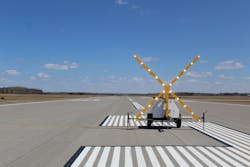Hali-Brite developed its RCM-D L-893(L) lighted runway closure marker in 2005 to improve pilot’s ability to discern a runway closure. This product allows pilots to recognize a runway closure from up to 25 miles away, providing a safer alternative to unlit runway closure makers.
“These are obviously very difficult to see at night providing very little notice, if any at all, to a closed runway situation,” Gabe Aldridge and Wes Wagner, owners of Hali-Brite, said when asked about unlit runway closure markers. “This created a significant safety risk to the airport, the pilots and the many patrons of air travel.”
The RCM-D L-893(L) lighted runway closure marker can be used night and day to denote closures for various runway projects. During the day, the RCM-D L-893(L) lighted runway closure marker’s lights are brighter than they are at night. The built-in photocell dims the lights to prevent pilots from being blinded as the sun starts to set.
“Early on in testing phases, it was quickly realized that during nighttime use, the lights were way too bright — like when someone forgets their brights are on and you drive past squinting and looking at the shoulder. The automatic dimmer dims the intensity down for maximum visibility, but also acceptable brightness levels for pilots,” Aldridge and Wagner said.
The RCM-D L-893(L) lighted runway closure marker uses 20 individual LED lights, an upgrade from the PAR38 Halogen bulbs Hali-Brite used in earlier models.
“[The Halogen bulbs] used in earlier models presented a significant issue with airports and contractors,” Aldridge and Wagner said. “Even if they did find a bulb to work, the units were no longer FAA certified, and did not flash or dim correctly with LED bulbs.
“Originally we thought to make a redesign/retrofit just using an LED bulb and making the appropriate modifications to our electronics. The problem with the LED bulbs is the market is extremely unpredictable. We needed a consistent lamp that was cost effective for the end user and also one that we could guarantee the quality.”
Hali-Brite decided to manufacture its own lamp modules to guarantee the dimming mechanism works and provides an identical appearance to pilots.
“On the old model you had to replace bulbs often. The nature of the machine being set up, taken down and set up again, was hard on light bulbs and a constant battle to keep the bulbs changed. The new LED model has 50,000 hours of life, so no more bulbs ever,” commented Aldridge and Wagner.
Aldridge and Wagner realized their existing customers wouldn’t want to buy a new set of lighted runway closure markers when they made this change. Hali-Brite designed and built an LED upgrade kit consisting of new electronics and a new LED “X” assembly when the company redesigned the lighted runway closure marker. Companies using an older version of the product don't have to buy a new set.
Aldridge and Wagner said their customers use the RCM-D L-893(L) lighted runway closure marker for anything from snowplowing to resealing or complete runway renovations.
“Most airports that have runway lights and commercial traffic have a set of lighted runway closure markers,” Aldridge and Wagner said. “Very commonly, as airports grow and construction takes place, the engineer will specify that the contractor supplies a set of lighted runway closure markers for use during the runway construction project. It is very common at completion of the project that the contractor is to hand them over to the airport for permanent ownership.”
Hali-Brite’s lighted runway closure markers are FAA certified, meaning they can be set up in five minutes or less and meet or exceed the FAA requirements for lighted runway closure markers.
“Long story short, we built it to adhere to the standards of Airport Lighting Equipment, date 9/26/2012, AC No: 150/5345-53D and 150-5370-2G. After building these, we sent units to ETL (Intertek),” Wagner said, noting Intertek is approved by the FAA to certify manufacturer’s products to FAA standards. “Our runway closure marker went through rigorous testing by this third party and passed. Once passed, they provide us with our certificate, and our product is then listed on the FAA listing of certified equipment.”
Airport workers tow the lighted runway closure marker behind a truck. Employees can tandem tow up to two lights at a time, but customers must have the rear receiver hitch. The recommended speed for highway towing is 45 miles per hour, while off-road towing is 10 miles per hour.
Once they reach the runway, the airport employee levels the RCM-D L-893(L) lighted runway closure marker using the rear-leveling jack. The employee then unlatches and extends the arms of the cross before starting the machine and turning on the circuit breakers to activate the LED lights. The LED lights blink; they are on for 2.5 seconds and off for 2.5 seconds.
Aldridge and Wagner noted their customers are happy with how little maintenance the RCM-D L-893(L) lighted runway closure markers need.
The product’s fuel filter and oil should be changed every 250 hours. The air filter should be changed every 500 hours and the belt should be changed every 1,000 hours. The lighted runway closure marker should be refueled every 120 hours of operation and employees should check the engine oil and coolant levels after every fuel fill.
Hali-Brite built the lighted runway closure marker to survive in all environments. Aldridge and Wagner said the company shipped units all around the world, citing Alaska, Puerto Rico and India as examples. The rated operating temperature of a Hali-Brite lighted runway closure marker is –40 to 130 degrees Fahrenheit and 95 percent relative humidity. It was tested to withstand 80 mile per hour winds and direct exposure to solar radiation.
Customers can also choose to purchase a cover for the lighted runway closure marker if storing the product outside.


